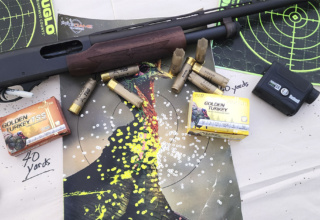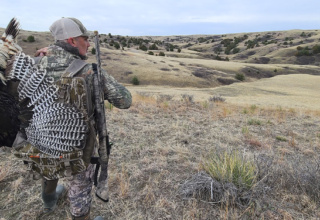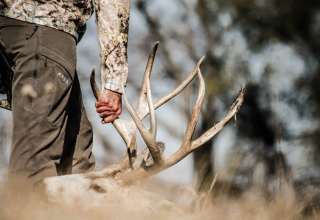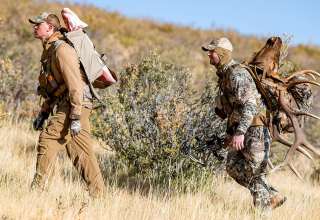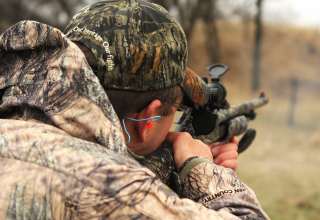Hunting gobblers in the rolling hills of the West is a whole other ball game and requires different methods for hunters to notch a tag.
by Elle Lawrence
If you’re feeling adventurous and plan to chase western gobblers instead of eastern birds, you’re going to need a few more tricks up your sleeve to call in a Tom.
Understand the Terrain
Unlike eastern turkey hunting, where you find yourself in thick woods most of the hunt, Merriam’s and Rio Grandes are known for strutting in the large open plains of the West. There are positives and negatives to that.
The good news is that this makes scouting easier and glassing up birds while hunting much more likely. The bad news is that with little foliage to hide behind, a turkey can spot you coming from a mile away.
Use the terrain to your advantage. Plan on glassing from high vantage points to watch birds from afar to see where they pitch down and where they head for the afternoon. When it’s clear what direction the turkeys are feeding towards, use the rolling hills to make a large circle around the flock to get in front and cut them off. If you’re stealthy enough, you’ll have a shot at the boss Tom.
One of the most vital tactics to hunting turkeys in western states is to roost birds. If legal shooting light is running out when you see a flock of turkeys, watch where they roost and look for ambush spots for the morning. If you haven’t had luck all day and light is fading, hop in the truck and go for a drive to spot birds heading to bed. Mark the location and a spot you plan to set up in the morning and get after it before the sun comes up.
Bring the Right Calls
You’re hunting large expanses of land and your calls need to be able to be heard a few hills over. If a slate is your favorite, by all means bring it, but a box call is golden in the West. A box can be loud or soft, depending on your needs, making it a versatile call to have in your vest. At times, the wind can whip fiercely, making soft clucks and purrs useless. Rip a loud locator yelp on your box call to cut the wind and reach turkeys a few valleys over.
Mouth calls are also beneficial to call in a Merriam or Rio. Use your box or slate at the same time you’re making clucks with your mouth. The more you sound like a group of hens, the better. When ‘ol Tom is strutting his way to you but hangs up just out of range, send out a soft purr with your mouth to entice him to come closer.
Blend In
Turkeys are known for their keen eyesight, and Merriams and Rios are no different. In fact, since it’s hard to find cover in the wide-open West, camouflage is of the utmost importance.
Utilize a pattern such as Veil Camo’s West River Verdant as it blends both the greens of spring with the browns and yellow of the prairie. Veil camo is on the cutting-edge of patterns and utilizes scientifically engineered designs to make you blend into your environment.
Don’t forget the usual turkey hunting accessories such as gloves, face mask, and hat. Be sure that no colors are visible on your garb, especially red and blue.
Fanning
First things first—don’t even think about whipping out a tail fan if you’re hunting public land. That’s way too risky, no matter how badly you want to kill a gobbler. But fanning is a great technique to draw in western birds—and it’s fun.
Why does fanning, or “reaping”, work so well? Because it’s mating season! Seeing another Tom working his way towards his ladies does not sit well with other gobblers. Most times, the mere sight of another tail fan causes a Tom to come running or strutting directly toward you, looking for a fight.
To be as realistic as possible, utilize a turkey fan from a past gobbler you’ve shot. If that’s not available, turkey reaping decoys work just fine. Make sure it’s a big fan to help conceal yourself behind it.
When is the best time to whip out the fan? Most of the time, it’s when you’ve spotted a strutter in the middle of a field hanging out with a bunch of hens. This Tom has ignored your calls, and for good reason. He has a flock of ladies—why should he leave them?
Put your shotgun in your shooting hand, the fan in your off hand, and start crawling, being sure to keep your head down and behind the fan. Slowly make your way towards the turkeys, moving the fan as realistically as possible, tilting the fan back and forth. When the boss gobbler spots you and starts making his way towards you, stop crawling and continue to move the fan until he is close enough for a shot.
- Judging Western Game on the Hoof - July 8, 2020
- Understanding Hunting Packs - June 9, 2020
- Turkey Load Patterning 101 - March 16, 2020









